MBB Bo 105
The Messerschmitt-Bölkow-Blohm Bo 105 is a light, twin-engine, multi-purpose helicopter developed by Bölkow of Ottobrunn, West Germany. It was the first light twin-engine helicopter in the world, and the first rotorcraft that could perform aerobatic maneuvers such as inverted loops.[5][6] The Bo 105 features a revolutionary hingeless rotor system, at that time a pioneering innovation in helicopters when it was introduced into service in 1970. Production of the Bo 105 began at the then-recently merged Messerschmitt-Bölkow-Blohm (MBB).
| Bo 105 | |
|---|---|
.jpg) | |
| A Bo 105 flying with Luftrettung Bundesministerium des Innern | |
| Role | Light utility helicopter |
| National origin | West Germany |
| Manufacturer | Messerschmitt-Bölkow-Blohm (MBB) |
| First flight | 16 February 1967 |
| Introduction | 1970 |
| Status | In service |
| Primary users | Republic of Korea Army Indonesian Army Spanish Army Philippine Navy |
| Produced | 1967–2001[1][2] |
| Number built | 1,500+[1] |
| Unit cost | |
The main production facilities for producing the Bo 105 were located in Germany and Canada; due to the level of export sales encountered, additional manufacturing lines were set up in Spain, Indonesia, and the Philippines.[7] MBB became a part of Eurocopter in 1991, who continued production of the type until 2001. The Bo 105 was formally replaced in Eurocopter's product range by the newer Eurocopter EC135.
Development
In 1964, development work began at Bölkow upon the helicopter that would become the Bo 105, although work on the hingeless rotor it would use had begun earlier.[8] On 16 February 1967, the second Bo 105A prototype conducted its maiden flight at Ottobrunn in Germany; the first public demonstration was held in May 1967.[1] The test program was broken down into stages as the Bo 105 comprised a new airframe, new rotor system, and a new engine; thus the flying Bo 105 prototype was initially equipped with a main rotor from Westland Helicopter's Scout rotorcraft and a pair of Allison Model 250 turboshaft engines instead of their production counterparts.[8] Sud Aviation worked with Bölkow on developing the rotorcraft; an Alouette II helicopter was modified with the Bo 105's rotor and used to test its performance envelope. The third Bo 105 prototype was equipped with the initial production standard MAN Turbo 6022 turboshaft engines; six pre-production Bo 105s were constructed for testing.[8]
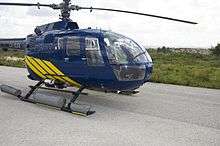
On 13 October 1970, the German Civil Aviation Authority certified the Bo 105; initial deliveries for the first customers, ADAC Air Rescue and the Bavarian State Police, took place shortly thereafter. In 1972, further type certification was granted by the Federal Aviation Administration (FAA) and the Civil Aviation Authority (CAA), enabling export orders from the United States and Britain respectively, which soon followed.[2] In 1972, an improved version of the rotorcraft with more powerful engines, the Bo 105C, was developed; this model quickly superseded the Bo 105A.[2] On 25 September 1973, the prototype Bo 106 performed its first flight;[9] the Bo 106 shared many similarities to the Bo 105, the principal difference being a widened cabin area, capable of seating three abreast in the front row and four abreast in the rear of the cabin. However, nothing further came of the Bo 106 project.[10]
In 1976, the Bo 105CB, equipped with more powerful Allison 250-C20B engines, was introduced. The Bo 105C was further developed to become the Bo 105CBS, the primary change being a fuselage stretch of 10 inches to meet American demand for emergency medical service (EMS) operations; this version was often referred to as the Bo 105 Twin Jet in the United States. US aerospace firm Boeing-Vertol served as a partner in the type's production and further development, and marketed the BO 105 in the US.[3][11] The Bo 105 CB and the Bo 105 CBS variants were also subject to license manufacturing agreements, leading to them being produced by the Philippine Aerospace Development Corporation in the Philippines, Indonesian Aerospace (IPTN) in Indonesia, and Construcciones Aeronáuticas SA (CASA) in Spain in addition to the main production line in Germany.[2][12]
In 1984, the Bo 105LS was developed with the enlarged fuselage of the Bo 105CBS combined with more powerful Allison 250-C28C engines to increase the maximum take-off weight as well as hot-and-high flight performance; the Bo 105 LS was manufactured under a cooperative arrangement with Eurocopter Canada.[2] Improvements and modifications to the Bo 105 LS continued until 1995.[2]
Production of the Bo 105 by Eurocopter formally ended in 2001, principally due to the type having been superseded by the more modern Eurocopter EC135, itself a direct development from the Bo 105. By the end of production, 1,406 rotorcraft had been manufactured and delivered to operators in 55 nations worldwide.[2]
Design
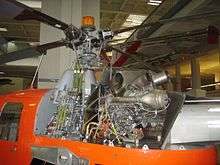
The Bo 105 has a reputation for having high levels of maneuverability; certain variants have been designed for aerobatic maneuvers and used for promotional purposes by operators, one such operator in this capacity being professional pilot Aaron Fitzgerald, flying for Red Bull.[13][14] During the 1970s, the Bo 105 was known for having a great useful load capacity and higher cruise speed than the majority of its competitors.[15] While not being considered a visually attractive helicopter by some pilots, the Bo 105 was known for possessing steady, responsive controls and a good flight attitude.[4] Most models could perform steep dives, rolls, loops, turnovers, and various aerobatic maneuvers; according to MBB the Bo 105 is cleared for up to 3.5 positive G force and one negative.[16] One benefit of the Bo 105's handling and control style is superior takeoff performance, including significant resistance to catastrophic dynamic rollover;[17] a combination of light weight and the twin-engined configuration enables a rapid ascent in a performance takeoff.[18]
Perhaps the most significant feature of the Bo 105 is its rotor blades and rotor head. The rotor system is entirely hingeless, the rotor head consisting of a solid titanium block to which the four blades are bolted;[19] the flexibility of the rotor blades works to absorb movements typically requiring hinges in most helicopter rotor designs.[16] The rotor blades are made from reinforced-plastic glass-fiber composite material; the flexibility of the main rotor allows for active elements other than rotor pitch changes to be removed, greatly simplifying maintenance and extending blade lifespan.[20] The reliability of the advanced rotor system is such that, in over six million operating hours across the fleet, there was a total of zero failures (as of 1991).[21] The rigid rotor blade design adopted on the Bo 105 has been partially responsible for the type's agility and responsiveness; it remained an uncommon feature on competing helicopters throughout the Bo 105's production life.[17]
Military operators would commonly operate the type at a very low altitude to minimise visibility to enemies, the Bo 105 being well matched to such operations, as the helicopter's flight qualities effectively removed or greatly minimised several of the hazards such a flight profile could pose to pilots.[22] When outfitted with optional auxiliary fuel tanks, a basic model Bo 105 had a flight endurance of roughly five hours under load.[18] In the event of a single engine failure, the Bo 105 could typically continue its flight, albeit with a reduction in cruise speed and range.[20] Besides the two pilots, the cabin can be configured to accommodate up to three passengers on a single rear bench, which can be removed to make room for cargo or a stretcher, which can be loaded and unloaded via the large clamshell doors located at the rear of the fuselage.[23] In a maritime context, the BO 105 can be equipped with auxiliary fuel tanks, emergency flotation equipment, an inflatable life raft, folding rotor blades and high skid landing gear.[24]
Operational history
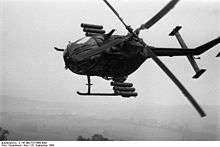
In 1975, the German Army decided to procure a specialist anti-tank version armed with up to six Euromissile HOT missiles, designated as the Bo 105 PAH-1. A total of 212 Bo 105 PAH-1s were delivered between 1979 and 1984.[2] German Army leaders saw the PAH-1 as a temporary measure only, having originally sought a more capable anti-tank helicopter; they were particularly dissatisfied with the PAH-1's inability to perform nighttime combat missions and its self-protection capabilities; ultimately, the Eurocopter Tiger was developed as a replacement.[25] In 1977, the German Ministry of Defence selected the Bo 105C for its light observation helicopter (VBH) program, leading to the procurement of another 100 rotorcraft.[2]
During the 1970s, MBB issued a license to produce the Bo 105 to Indonesian Aerospace (IPTN) as part of a wider agreement to help develop Indonesia's aviation industry. Within ten years, manufacture of the Bo 105 had been entirely localised within IPTN's own facilities.[26] The Bo 105 has been used by various branches of the Indonesian National Armed Forces; military-operated Bo 105s have been reportedly used during the 1999 East Timorese crisis and the Papua conflict.[27] Indonesian Bo 105s have also participated in several large-scale joint exercises.[28][29]
The Mexican Navy operated a number of armed Bo 105s to perform maritime reconnaissance duties; during the early 1980s, Mexico procured a number of a Uribe-class patrol vessels which were equipped to handle the Bo 105 for off-shore operations.[30] In 2005, work was completed on a series of upgrades to 11 of the Mexican Navy's Bo 105s, having received Forward looking infrared (FLIR) sensors, Global Positioning System (GPS) receivers, search radars, new rotor blades, armament pylons, and other changes.[31] In November 2014, Jet Rescue Air Ambulance inaugurated Mexico's first dedicated civil air ambulance rotorcraft using a Bo 105.[32]
During the late 1990s, the Republic of Korea Army aviation procured a number of Bo 105s as part of an ongoing drive to improve the force's reconnaissance and surveillance capabilities; these were manufactured under a co-production arrangement between Eurocopter and the newly formed Korea Aerospace Industries (KAI), receiving the designation Korean Light Helicopter (KLH), KAI also promoted the type to export customers.[33][34]
The Bo 105 gained widespread use by emergency medical service (EMS) / medevac operators; in 1998, Flying Magazine reported that between the Bo 105 and the MBB/Kawasaki BK 117 (a newer rotorcraft derived from the Bo 105), MBB held 35% of the EMS market share.[35] The first EMS-orientated Bo 105 in Scotland entered service in 1989; in November 2015, the last Bo 105 air ambulance operated in Britain was retired, the type having typically been replaced by the newer Eurocopter EC135.[36] In 2009, the last Bo 105 to be produced was purchased by Canadian EMS specialist Dam Helicopters.[37][38]
In May 2014, Airbus Helicopter reported that, worldwide, the Bo 105 had accumulated 8 million flight hours, and that approximately 700 Bo 105s remained in service.[39]
Since 1979, the German Army has received 312 B0 105s, comprising 212 PAH anti-tank versions and 100 M-versions as liaison and observation helicopters. The helicopter was retired from German Army service on 13 December 2016 with an 18-aircraft formation flyby from their base in Celle. The Bohicans, as their pilots were called, had clocked over 1.38 million flying hours.[40]
Trivia
Since 2011 a BO 105 in typical yellow rescue look is part of an art installation by Alfred Gockel at the Kamener Kreuz (Motorway intersection of A1 and A2 in Germany).[41][42]
Variants
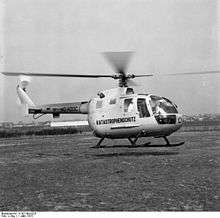
The variants used by the German Army are the Bo 105P and Bo 105M.
- Bo 105A
- First production model primarily for civil use and equipped with two Allison 250-C18 turbine engines.
- Bo 105ATH
- Anti-tank version for the Spanish Army.[12]
- Bo 105C
- Initial version. Developed in 1972 and equipped with two Allison 250-C20 turbines engines.[12]
- Bo 105CB
- Light observation, utility transport version. Developed in 1976 and equipped with two Allison 250-C20B turbine engines of which 30 were delivered to The Royal Netherlands Air Force.[12]

- Bo 105CBS
- Utility transport version, with the fuselage stretched by 10 inches and an extra window for emergency medical service duties.[12]
- EC-Super Five
- High performance version of the Bo 105CBS.
- Bo 105CBS-5
- Also known as Superfive, with increased lifting capabilities similar to the LS A3 Superlifter
- Bo 105D
- UK certified offshore version.
- Bo 105GSH
- Armed scout version for the Spanish Army.[12]
- Bo 105HGH
- A high speed research variant wint aerodynamic refinements, such as a rotor head fairing, rear fuselage fairing, small individual skids and 6 m (20 ft) long fixed auxiliary wings.
- Bo 105 KLH
- license-produced combat version of CBS-5 custom-fitted with Korean mission equipment package including communication, navigation, electronic warfare and target acquisition system,[43] to meet Republic of Korea Army's operational requirements. KLH also has greatly improved rotor blade and transmission system. 12 are in service.
- Bo 105LOH
- Observation version for the Spanish Army.[12]
- Bo 105LS A1
- Developed in 1984 with stretched fuselage and two Allison 250-C28C turbine engines.
- Bo 105LS A3
- Developed in 1986 with maximum take-off weight increased to 2,600 kg.
- Bo 105LS A3 "Superlifter"
- Developed in 1995 with maximum mission weight increased to 2,850 kg.
- Bo 105M
- With its army designation "VBH" (Verbindungshubschrauber; 'liaison chopper'), is a light transport and surveillance helicopter.[12] They were outphased and replaced by disarmed and modified PAH1.
- Bo 105MSS
- Maritime version, fitted a search radar.
- Bo 105P/BSH
- Proposed escort version for the German Army, armed with Stinger air-to-air missiles.[12]
- Bo 105P/PAH-1
- With its army designation "PAH-1" and "PAH-1A1" for the upgraded version (PAH=Panzerabwehrhubschrauber; 'Tank-defence helicopter'), is an anti-tank helicopter armed with wire-guided HOT ATGMs (HOT2 for the upgraded A1 version).[12] Following the arrival of the Eurocopter Tiger attack helicopter, some were retired while others disarmed and downgraded to the VBH version for continued service.
- Bo 105P/PAH-1A1
- Improved anti-tank version for the German Army, fitted with six HOT missile tubes.[12]
- Bo 105P/PAH-1 Phase 2
- Proposed night attack version for the German Army.[12]
- Bo 105S
- Search and rescue version.
- Bo 105/Ophelia
- Test and trials aircraft fitted with a mast-mounted sight.[12]
- NBO-105
- Were Manufactured by IPTN under license from MBB (now Airbus Helicopters) 1976–2011; only rotors and transmission now supplied by Germany; originally NBO-105 CB, but stretched NBO-105 CBS available from 101st aircraft onwards. 122 were produced, Dirgantara Indonesia stopped production in 2008.
- NBO-105S
- Stretched version.
- Bo 105 Executaire
- Boeing Vertol and Carson Helicopters manufactured a 24.5 cm stretched version of the Bo 105 under license as the Executaire in an attempt to break into the U.S. light helicopter market, but sales were dismal.[44]
- Bo 105E-4
- 12 German Army Bo 105P upgraded and overhauled for a 10 million euro contract and donated to Albania first batch delivered in 2006, the helicopters have better performance and avionics. The conversion of other Bo 105 helicopters from the German Armed Forces is also under consideration with a view to future sales.[45]
- Bo 106
- Widened cabin to seat 7 instead of 5. First flight was on 26 September 1973.[46] A single helicopter of that variant has been made (registration D-HDCI, serial no. 84). The Bo 106 was also equipped with more powerful Allison 250 C 20B engines. In 1981, the German air rescue organization Deutsche Rettungsflugwacht/DRF Luftrettung bought that prototype and had it rebuilt into a 105 CB-2 with a standard cabin. It flew for DRF until November 1993 under the registration D-HCCC, but in 1994 it was put aside to gain spare parts for another DRF helicopter (Bo 105 CBS-S, registration D-HNNN, serial number 662).
- PADC Hummingbird
- An unlicensed development of the Bo 105C with revised cockpit structure.
Operators
Military
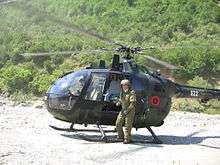
.jpg)
- Uruguayan Navy[47]
Government
- Buenos Aires Province Police[48]
- Santa Fe Province Police
- Policía Federal Argentina
- Módena Helicópteros lease to paramedic services.

- German State Police[50]
Former
- Canadian Coast Guard[57] - all retired in 2016 after Bell 429 delivered
.jpg)
_(8738018957).jpg)
_09221_90_(7585798722).jpg)
Accidents and incidents
Specifications (Bo 105CB)
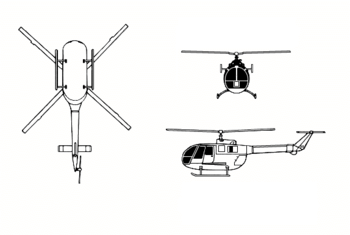
Data from Jane's All the World's Aircraft 1988-89[79]
General characteristics
- Crew: 1 or 2 pilots
- Capacity: 3 or 4 passengers
- Length: 11.86 m (38 ft 11 in) (total length - including rotors)
- Height: 3.00 m (9 ft 10 in)
- Airfoil: NACA 23012
- Empty weight: 1,276 kg (2,813 lb)
- Max takeoff weight: 2,500 kg (5,512 lb)
- Fuel capacity: 570 L (150 US gal; 130 imp gal)
- Powerplant: 2 × Allison 250-C20B turboshaft engines, 310 kW (420 shp) each
- Main rotor diameter: 9.84 m (32 ft 3 in)
- Main rotor area: 76.05 m2 (818.6 sq ft)
Performance
- Maximum speed: 242 km/h (150 mph, 131 kn)
- Cruise speed: 204 km/h (127 mph, 110 kn) (best range cruise)
- Never exceed speed: 270 km/h (170 mph, 150 kn)
- Range: 657 km (408 mi, 355 nmi) at 1,525 m (5,000 ft) (standard fuel, maximum payload)
- Ferry range: 1,112 km (691 mi, 600 nmi) at 1,525 m (5,000 ft) (with auxiliary tanks)
- Endurance: 3 hr 30 min (standard fuel, maximum payload)
- Service ceiling: 5,200 m (17,000 ft)
- Rate of climb: 8.00 m/s (1,575 ft/min)
Armament
- Missiles: 6x Euromissile HOT (Bo 105 P) or 8x BGM-71 TOW
See also
Related development
Aircraft of comparable role, configuration and era
Related lists
References
Citations
- "Bölkow Bo 105 - History of EADS". EADS. Archived from the original on 29 September 2007. Retrieved 10 March 2007.
- Gotzhein, Christina. "Eurocopter Celebrates the 40th Anniversary of the Maiden Flight of the BO105, the World's First Light Twin-Turbine Production Helicopter." Archived 19 October 2016 at the Wayback Machine Eurocopter, 15 February 2007.
- Weeghman 1975, p. 54.
- Moll 1991, p. 105.
- Moll 1991, p. 96.
- looping capability Archived 17 November 2015 at the Wayback Machine according to the German Air Force museum at Gatow
- Moll 1991, pp. 103–104.
- Rieck, Joan M. "Bölkow's Bo105." Archived 4 March 2016 at the Wayback Machine Flight International, 18 May 1967, p. 794.
- Taylor 1976, p. 73.
- Air International May 1976, p. 246.
- "A Marriage that Lasted." Archived 17 November 2015 at the Wayback Machine Flight International, p. 30. 31 May 2004.
- Stemp 2012, p. 339
- "Sports & Entertainment News | Teams & Athletes". Red Bull USA. Archived from the original on 28 April 2009. Retrieved 19 December 2012.
- Wise, Jeff. "How to Fly a Helicopter—Upside Down." Archived 7 November 2015 at the Wayback Machine Popular Mechanics, 25 May 2012.
- Weeghman 1975, pp. 54–56.
- Moll 1991, p. 101.
- Moll 1991, p. 103.
- Moll 1991, p. 104.
- Moll 1991, pp. 98, 101.
- Weeghman 1975, p. 56.
- Moll 1991, p. 98.
- Moll 1991, pp. 102–103.
- Weeghman 1975, p. 57.
- "Characteristics of the Messerschmitt-Bolkow-Blohm (BO-105-CBS) helicopter." Archived 17 November 2015 at the Wayback Machine Canadian Coast Guard, Retrieved: 6 November 2015.
- Krotz 2011, pp. 59–61.
- Amir 2012, p. 106.
- "STOP Arming Indonesia." Archived 4 March 2016 at the Wayback Machine European Network Against Arms Trade, 1994.
- Keck, Zachary. "Indonesia to Conduct Massive Military Drill." Archived 15 October 2015 at the Wayback Machine The Diplomat, 21 May 2014.
- Rahmat, Ridzwan. "Indonesian navy conducts first helicopter landing on USN LCS." Archived 18 October 2015 at the Wayback Machine IHS Jane's Navy International, 18 August 2015.
- "Mexico Study: Chapter 5. National Security." Archived 10 January 2016 at the Wayback Machine marines.mil, Retrieved: 1 November 2015.
- "Procument, Mexico." Jane's Sentinel Security Assessment , 11 February 2011.
- "First full HEMS for Mexico." Archived 8 December 2015 at the Wayback Machine AirMed & Rescue Magazine, 26 November 2014.
- Moon, Chung-in. and Jin-Young Lee. "The Revolution in Military Affairs and the Defence Industry in South Korea." Archived 8 December 2015 at the Wayback Machine Security Challenges, vol. 4, no. 4. (Summer 2008), pp. 117-134.
- Doyle, Andrew. "KAI aims high." Archived 8 December 2015 at the Wayback Machine Flight International, 9 October 2001.
- "EMS Safety Record Soars." Flying Magazine, December 1988. Vol. 115, No. 12. p. 11.
- "'End of an era' as last Bolkow air ambulance to retire." Archived 22 November 2018 at the Wayback Machine BBC News, 24 September 2015.
- Careless, James. "Dam Good." Archived 10 January 2016 at the Wayback Machine Helicopters Magazine, 30 June 2009.
- "Dam Helicopters Inc. takes to the sky with the last new BO105 LS." Archived 10 January 2016 at the Wayback Machine Airbus Helicopters , 1 June 2009.
- "BO105 Continues as Workhorse, Topping 8 Million Hours." Archived 10 January 2016 at the Wayback Machine Rotor & Wing, 27 May 2014.
- Last Of The Bohicans Archived 29 December 2016 at the Wayback Machine - Aviationweek.com, 23 December 2016
- https://www.derwesten.de/incoming/acht-engel-fuer-das-kamener-kreuz-id5010124.html
- https://rth.info/news/news.php?id=1070
- John Pike. "Korean Light Helicopter [KLH]". Globalsecurity.org. Archived from the original on 2 March 2011. Retrieved 19 December 2012.
- "MBB (Eurocopter) Bo105" (in German). WaffenHQ.de. Archived from the original on 29 March 2007. Retrieved 28 April 2007.
- "Company". Airbus. Archived from the original on 5 December 2008. Retrieved 7 April 2018.
- Flug Revue, issue January 1974, p. 4.
- "World Air Forces 2018". Flightglobal Insight. 2018. Archived from the original on 6 February 2018. Retrieved 25 August 2018.
- "Control and Prevention". Archived from the original on 27 July 2009. Retrieved 18 December 2012.
- "Mbb bo-105ls-a3". Archived from the original on 10 October 2013. Retrieved 18 December 2012.
- "German Polizei MBB-BO-105CBS". .eurocopter.com. Archived from the original on 9 April 2013. Retrieved 18 December 2012.
- "Dutch Aviation Police MBB Bo105". Archived from the original on 10 October 2013. Retrieved 18 December 2012.
- Mladenov Air International December 2016, pp. 84–86.
- "SAPS Air Wing". defenceweb. Archived from the original on 17 November 2015. Retrieved 18 December 2012.
- "Servicio de Vigilancia Aduanera". aeroflight.co.uk. Archived from the original on 7 January 2013. Retrieved 18 December 2012.
- "Así es como el Cuerpo Nacional de Policía realiza una operación antiterrorista -". Archived from the original on 23 March 2013. Retrieved 18 December 2012.
- "Guardia Civil (CASA) BO-105CB". aeroflight.co.uk. Archived from the original on 7 January 2013. Retrieved 18 December 2012.
- "Fleet - Helicopter Services Across Canada - Canadian Coast Guard". ccg-gcc.gc.ca. Archived from the original on 5 August 2014. Retrieved 20 December 2012.
- "fuerza aerea de chile Bo105". Archived from the original on 24 June 2015. Retrieved 12 January 2015.
- "World's Air Forces 1987 pg.46". flightglobal.com. Archived from the original on 22 February 2014. Retrieved 5 February 2014.
- "World's Air Forces 1987 pg.50". Archived from the original on 2 November 2013. Retrieved 5 February 2014.
- "Lääkäri- ja pelastushelikopteritoiminnan järjestäminen ja rahoitus". Sisäasiainministeriön julkaisu 1/2004 (in Finnish). Sisäasiainministeriö. 2004. p. 40. ISBN 951-734-568-2. ISSN 1236-2840. Archived from the original on 7 April 2019. Retrieved 7 April 2019.
- "Turku Historia Medi-Heli" (in Finnish). Archived from the original on 7 April 2019. Retrieved 7 April 2019.
- "World Air Forces 2015". Flightglobal Insight. 2015. Archived from the original on 24 March 2015. Retrieved 4 January 2015.
- "World's Air Forces 1987 pg.65". flightglobal.com. Archived from the original on 16 May 2013. Retrieved 5 February 2014.
- "Koninklijke Luchtmacht Bo105". Archived from the original on 23 June 2015. Retrieved 12 January 2015.
- "World's Air Forces 1987 pg.73". flightglobal.com. Archived from the original on 21 May 2013. Retrieved 5 February 2014.
- "World's Air Forces 1987 pg.74". flightglobal.com. Archived from the original on 9 January 2015. Retrieved 5 February 2014.
- "World's Air Forces 1987 pg.78". flightglobal.com. Archived from the original on 8 January 2014. Retrieved 5 February 2014.
- "World's Air Forces 1987 pg.81". flightglobal.com. Archived from the original on 1 February 2014. Retrieved 5 February 2014.
- "Sudan: Information on the Puma, BO105, Bell 205, Bell 212 and Mi-24 helicopters used in Sudan, and on the Bell 206 helicopters used in the United Arab Emirates". Refworld. Archived from the original on 4 August 2016. Retrieved 18 June 2016.
- "Back from retirement, Sudan's BO-105s take to the skies". Oryx Blog. Archived from the original on 22 August 2016. Retrieved 18 June 2016.
- "World Air Forces 2004 pg. 88". flightglobal.com. Archived from the original on 9 January 2015. Retrieved 12 January 2015.
- "World's Air Forces 1987 pg.91". flightglobal.com. Archived from the original on 3 December 2013. Retrieved 5 February 2014.
- "World's Air Forces 1994 pg.58". flightglobal.com. Archived from the original on 22 February 2014. Retrieved 5 February 2014.
- "World's Air Forces 1987 pg.96". flightglobal.com. Archived from the original on 22 February 2014. Retrieved 5 February 2014.
- "MBB introduces corporate BK.117". flightglobal.com. 1990. Archived from the original on 17 November 2015. Retrieved 15 January 2015.
- "V/STOL 1968 (Bolkow BÖ105". flightglobal.com. Archived from the original on 18 November 2015. Retrieved 15 January 2015.
- "'Terrorist attack': Hijacked military helicopter strikes Venezuela court, ministry (PHOTOS, VIDEO)". RT. 28 June 2017. Archived from the original on 28 June 2017. Retrieved 28 June 2017.
- Taylor 1988, pp. 93–94.
Bibliography
- Amir, Sulfikar. "The Technological State in Indonesia: The Co-constitution of High Technology and Authoritarian Politics." Routledge, 2012. ISBN 1-13618-958-0.
- Apostolo, Giorgio (1984). The illustrated encyclopedia of helicopters. New York: Bonanza Books. ISBN 0-517-43935-2.
- Barrie, Douglas; Pite, Jenny (24–30 August 1994). "World's Air Forces". Flight International. Vol. 146 no. 4435. pp. 29–64. ISSN 0015-3710.
- "Bo 105 - A Versatile Success". Air International. Vol. 16 no. 5. May 1979. pp. 215–221, 246–248.
- Hatch, Paul (29 November – 5 December 1989). "World's Air Forces 1989". Flight International. Vol. 136 no. 4193. pp. 37–106.
- Hoyle, Craig (11–17 December 2012). "World Air Forces Directory". Flight International. Vol. 182 no. 5370. pp. 40–64. ISSN 0015-3710.
- Mlandenov, Alexander (December 2016). "Russia's Responders". Air International. Vol. 91 no. 6. pp. 78–87. ISSN 0306-5634.
- Moll, Taylor (November 1991). "To A BO 105 Pilot This Thing's Pretty: World's First Light Twin Helicopter Still Going Strong". Flying. Vol. 118 no. 11. pp. 96–105. ISSN 0015-4806.
- Krotz, Ulrich (2011). Flying Tiger: International Relations Theory and the Politics of Advanced Weapons. Oxford University Press. ISBN 0-1997-5993-6.
- Stemp, P. D. "Kites, Birds & Stuff - Aircraft of Germany: Volume 2 - E to H." Lulu, 2012. ISBN 1-29129-268-3.
- Taylor, John W. R. (1976). Jane's All The World's Aircraft 1976–77. London: Jane's Yearbooks. ISBN 0-354-00538-3.
- Taylor, John W R (editor) (1988). Jane's All the World's Aircraft 1988-89. Coulsdon, Surrey, UK: Jane's Information Group. ISBN 0-7106-0867-5.CS1 maint: extra text: authors list (link)
- Weeghman, Robert B. (April 1975). "Boeing's Teutonic Twin". Flying. Vol. 96 no. 4. pp. 54–57.
- "World's Air Forces". Flight International. Vol. 144 no. 4397. 24–30 November 1993. pp. 41–76. ISSN 0015-3710.
External links
| Wikimedia Commons has media related to Bo 105. |
- Eurocopter history on Bo 105
- Airliners.net info on Bo 105
- Bo 105 info from Federation of American Scientists
- Lahak Aviation Ltd. Israel Bo 105 EMS and VIP Operator
- Bo 105 Photos and Walk Arounds on Prime Portal